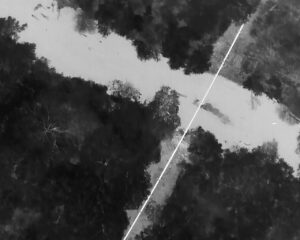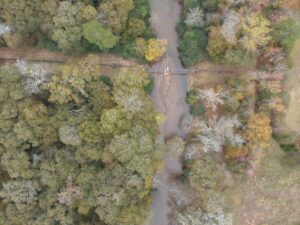A Birds-Eye-View
MetroConnects has been abuzz lately, and it is not just with the usual sound of busy crew members checking and cleaning pipes. It is the sound of employees training to use state-of-the-art drone technology to boost precision, help identify safety hazards, and provide huge amounts of data for our engineers, our Geographic Information Systems (GIS) team and our Operation and Maintenance (O&M) team so that they can do their work with the utmost efficiency. Drones, which are technically called “Unmanned Aircraft Systems” (UAS), offer birds-eye-views of MetroConnects right-of-way (ROW) easements and sewer mains, manholes, pump stations and other critical infrastructure that keep our systems running smoothly.
FAA Training
Currently, seven MetroConnects employees are training for the UAS program, with plans for more employees to participate. Training has included a one-week class that prepared employees for the Federal Aviation Administration (FAA) Part 107 pilot’s license test. Additional training involves hands-on flights and software training to build confidence for the employees. After completing the training, the employees will receive their FAA Remote Pilot Licenses, which they will renew every two years. The strict licensing process ensures that the drones will be flown safely and follow FAA regulations that prevent interference with local flight patterns and events.
Ariel Efficiency
The drones will be used primarily to inspect MetroConnects’ ROW easements in order to assess our ability to access sewer mains. The technology can inspect any infrastructure that is difficult to access, including pipes that cross aerially over rivers and creeks in densely vegetated areas. Importantly, the drones will be able to be flown in rainy weather, allowing crew members to inspect manholes in areas that would otherwise be difficult to reach. This will help MetroConnects to identify areas that are prone to Sanitary Sewer Overflows (SSOs) and help prevent the overflows before they happen. The drones will also be used for ariel photography in areas of active construction, which will be useful for our engineers and contractors.
The Equipment
MetroConnects currently owns two drones, one smaller and one larger, with plans to buy a third. One includes a thermal camera, which is rated to fly in rainy weather. It can identify problem areas when there is low visibility by capturing and creating an image using infrared radiation that represents the temperature of the object.
MetroConnects is excited to start this program and anticipates even more opportunities to use drones in the future, said Jake Tittle, MetroConnects Chief Information Officer. Currently, in the wastewater sector, drones are primarily used for visual data collection and infrastructure inspection, but the technology is quickly advancing. Karen Kelley, P.E., Senior Water Resources Engineer and research and development manager at CDM Smith, an engineering and construction firm, says that drone technology is moving into new and exciting directions, especially with sensors and machine learning. Scott Aldridge, Innovation and Disruptive Technologies Leader for CDM Smith, told WEFTEC NOW that it is estimated that the drone market and uses for drones are going to more than double in the next two to seven years, with the biggest increase happening in the utility sector. “In the near term, utilities are going to adopt using drones just for taking videos and images. … But the value of the drone is that it makes things safer. You get things done faster, and it’s a lot cheaper,” Aldridge told WEFTEC. “By 2030, I think there’ll be drones active at the majority of utilities.”

